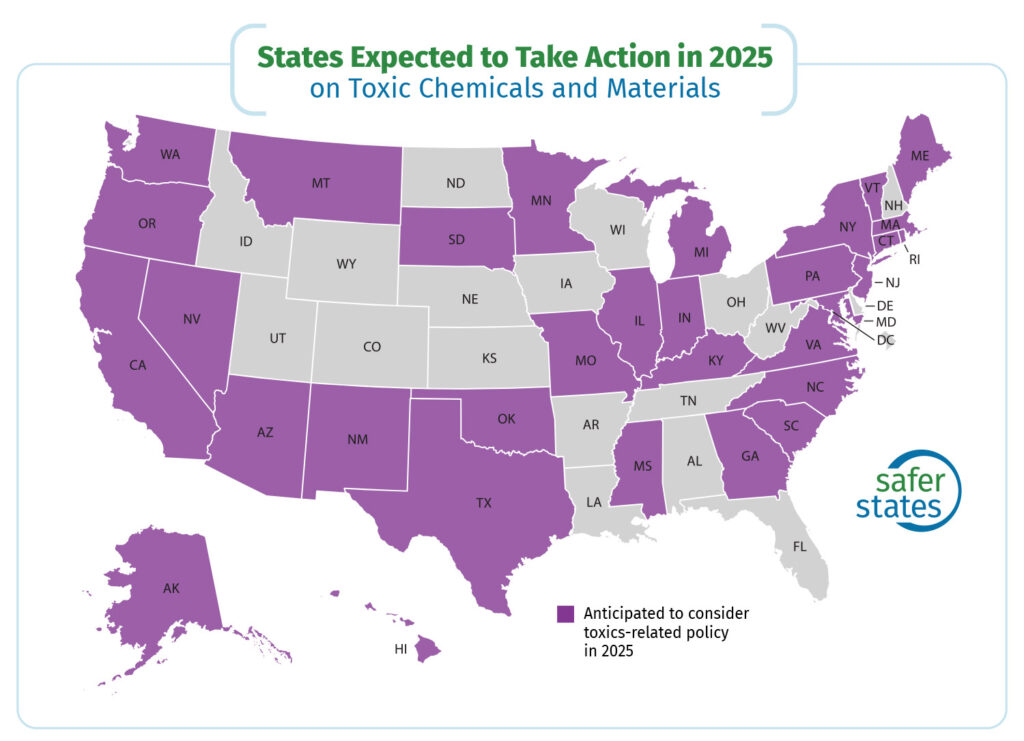Introduction
States have long been leaders in protecting communities from harmful chemicals. Over the past 20 years, states have prioritized addressing the most hazardous chemicals, requiring ingredient transparency, and incentivizing the transition to safer solutions. These state policies are grounded in rigorous, up-to-date science; protect children and other vulnerable populations; and prevent contamination of drinking water and expensive cleanups.
Safer States has been tracking and analyzing state action on toxic chemicals and pollution since 2010. Our 2025 analysis of policy and key rulemaking finds that states are continuing to lead the nation and the world toward driving safer solutions, specifically by:
- Transparency: Increasing transparency about ingredients in products.
- Phasing out the bad: Restricting chemicals and classes of chemicals based on the hazards to health and the environment (e.g. persistence, carcinogenicity, reproductive hazards).
- Promoting safer solutions: Requiring safer alternatives to be identified and supporting identification and investment in safer solutions.
- Accountability: Holding polluters accountable for pollution and providing resources for cleanup, source identification, and drinking water mitigation.
The analysis found that overall at least 32 states and the District of Columbia will likely consider at least 340 policies that address toxic chemicals in products such as PFAS, plastics, and cosmetics as well as other toxic pollution issues including PFAS discharge and sludge limits.
The 32 states that we anticipate will consider toxics policy are Alaska, Arizona, California, Connecticut, Georgia, Hawaii, Illinois, Indiana, Kentucky, Maine, Maryland, Massachusetts, Michigan, Minnesota, Mississippi, Missouri, Montana, Nevada, New Jersey, New Mexico, New York, North Carolina, Oklahoma, Oregon, Pennsylvania, Rhode Island, South Carolina, South Dakota, Texas, Vermont, Virginia, and Washington.

Key Trends for 2025
This year, state policies are focusing on several key areas, including:
- PFAS: States are expanding their policies to eliminate exposure to PFAS. In addition to introducing policies to remove unnecessary PFAS from products, more states are tackling industrial uses and discharges of PFAS as well as the spreading of contaminated sludge on farmland.
- Plastics: States are now turning to address the toxicity of plastics by introducing policies that reduce plastic use, eliminate the use of plastics made with the most hazardous chemicals (such as polystyrene and PVC), restrict the use of toxic additives, and address microplastics.
- Cosmetics: More states are joining California, Oregon, Washington, and Vermont to end the use of highly hazardous chemicals like PFAS and formaldehyde in personal care products and cosmetics and support the transition to safer products.
Policies under consideration in 2025 build on the progress made in recent years by states like California, Minnesota, Maine, New York, Vermont, and Washington. These six states have consistently been at the forefront of modeling successful approaches to preventing toxic threats to human health and the environment. Policies adopted by these states and others have successfully helped move the market away from some of the most harmful chemicals and demonstrated that we can move toward practical, safer solutions.
This market shift is demonstrated in Toxic-Free Future’s recent Retailer Report Card, which showed that more than half of the retailers evaluated had corporate policies to avoid the use of hazardous chemicals and plastics. And 68% had made progress toward reducing and eliminating the most hazardous chemicals and plastics from their products and packaging.